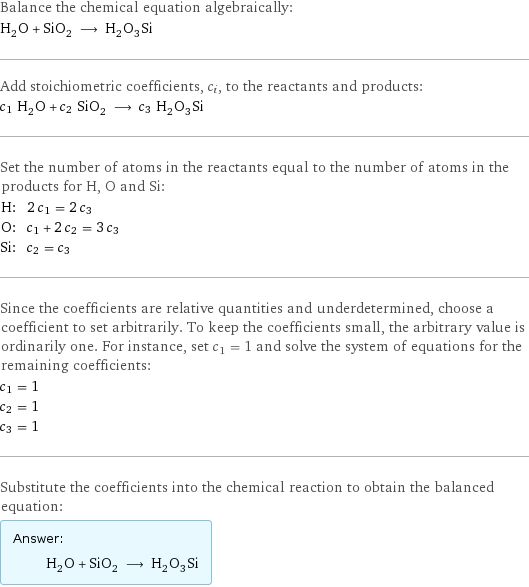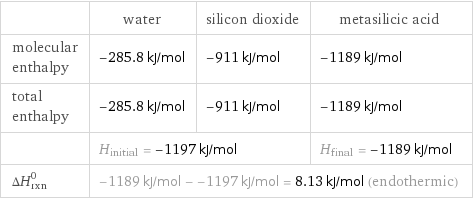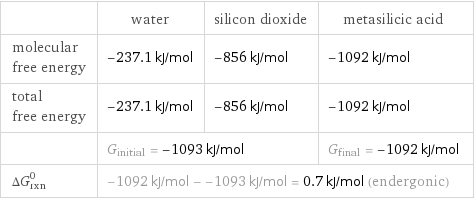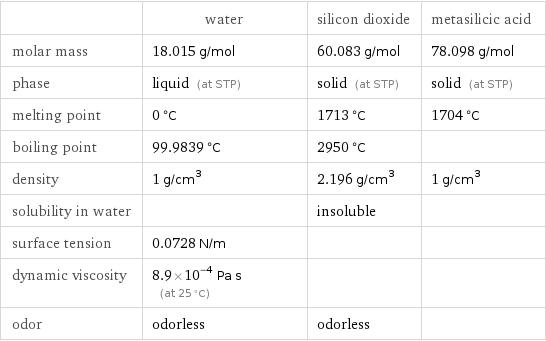Input interpretation

H_2O water + SiO_2 silicon dioxide ⟶ H_2O_3Si metasilicic acid
Balanced equation

Balance the chemical equation algebraically: H_2O + SiO_2 ⟶ H_2O_3Si Add stoichiometric coefficients, c_i, to the reactants and products: c_1 H_2O + c_2 SiO_2 ⟶ c_3 H_2O_3Si Set the number of atoms in the reactants equal to the number of atoms in the products for H, O and Si: H: | 2 c_1 = 2 c_3 O: | c_1 + 2 c_2 = 3 c_3 Si: | c_2 = c_3 Since the coefficients are relative quantities and underdetermined, choose a coefficient to set arbitrarily. To keep the coefficients small, the arbitrary value is ordinarily one. For instance, set c_1 = 1 and solve the system of equations for the remaining coefficients: c_1 = 1 c_2 = 1 c_3 = 1 Substitute the coefficients into the chemical reaction to obtain the balanced equation: Answer: | | H_2O + SiO_2 ⟶ H_2O_3Si
Structures

+ ⟶
Names

water + silicon dioxide ⟶ metasilicic acid
Reaction thermodynamics
Enthalpy

| water | silicon dioxide | metasilicic acid molecular enthalpy | -285.8 kJ/mol | -911 kJ/mol | -1189 kJ/mol total enthalpy | -285.8 kJ/mol | -911 kJ/mol | -1189 kJ/mol | H_initial = -1197 kJ/mol | | H_final = -1189 kJ/mol ΔH_rxn^0 | -1189 kJ/mol - -1197 kJ/mol = 8.13 kJ/mol (endothermic) | |
Gibbs free energy

| water | silicon dioxide | metasilicic acid molecular free energy | -237.1 kJ/mol | -856 kJ/mol | -1092 kJ/mol total free energy | -237.1 kJ/mol | -856 kJ/mol | -1092 kJ/mol | G_initial = -1093 kJ/mol | | G_final = -1092 kJ/mol ΔG_rxn^0 | -1092 kJ/mol - -1093 kJ/mol = 0.7 kJ/mol (endergonic) | |
Equilibrium constant
![Construct the equilibrium constant, K, expression for: H_2O + SiO_2 ⟶ H_2O_3Si Plan: • Balance the chemical equation. • Determine the stoichiometric numbers. • Assemble the activity expression for each chemical species. • Use the activity expressions to build the equilibrium constant expression. Write the balanced chemical equation: H_2O + SiO_2 ⟶ H_2O_3Si Assign stoichiometric numbers, ν_i, using the stoichiometric coefficients, c_i, from the balanced chemical equation in the following manner: ν_i = -c_i for reactants and ν_i = c_i for products: chemical species | c_i | ν_i H_2O | 1 | -1 SiO_2 | 1 | -1 H_2O_3Si | 1 | 1 Assemble the activity expressions accounting for the state of matter and ν_i: chemical species | c_i | ν_i | activity expression H_2O | 1 | -1 | ([H2O])^(-1) SiO_2 | 1 | -1 | ([SiO2])^(-1) H_2O_3Si | 1 | 1 | [H2O3Si] The equilibrium constant symbol in the concentration basis is: K_c Mulitply the activity expressions to arrive at the K_c expression: Answer: | | K_c = ([H2O])^(-1) ([SiO2])^(-1) [H2O3Si] = ([H2O3Si])/([H2O] [SiO2])](../image_source/41db217613fc355f76dcb61c75f91591.png)
Construct the equilibrium constant, K, expression for: H_2O + SiO_2 ⟶ H_2O_3Si Plan: • Balance the chemical equation. • Determine the stoichiometric numbers. • Assemble the activity expression for each chemical species. • Use the activity expressions to build the equilibrium constant expression. Write the balanced chemical equation: H_2O + SiO_2 ⟶ H_2O_3Si Assign stoichiometric numbers, ν_i, using the stoichiometric coefficients, c_i, from the balanced chemical equation in the following manner: ν_i = -c_i for reactants and ν_i = c_i for products: chemical species | c_i | ν_i H_2O | 1 | -1 SiO_2 | 1 | -1 H_2O_3Si | 1 | 1 Assemble the activity expressions accounting for the state of matter and ν_i: chemical species | c_i | ν_i | activity expression H_2O | 1 | -1 | ([H2O])^(-1) SiO_2 | 1 | -1 | ([SiO2])^(-1) H_2O_3Si | 1 | 1 | [H2O3Si] The equilibrium constant symbol in the concentration basis is: K_c Mulitply the activity expressions to arrive at the K_c expression: Answer: | | K_c = ([H2O])^(-1) ([SiO2])^(-1) [H2O3Si] = ([H2O3Si])/([H2O] [SiO2])
Rate of reaction
![Construct the rate of reaction expression for: H_2O + SiO_2 ⟶ H_2O_3Si Plan: • Balance the chemical equation. • Determine the stoichiometric numbers. • Assemble the rate term for each chemical species. • Write the rate of reaction expression. Write the balanced chemical equation: H_2O + SiO_2 ⟶ H_2O_3Si Assign stoichiometric numbers, ν_i, using the stoichiometric coefficients, c_i, from the balanced chemical equation in the following manner: ν_i = -c_i for reactants and ν_i = c_i for products: chemical species | c_i | ν_i H_2O | 1 | -1 SiO_2 | 1 | -1 H_2O_3Si | 1 | 1 The rate term for each chemical species, B_i, is 1/ν_i(Δ[B_i])/(Δt) where [B_i] is the amount concentration and t is time: chemical species | c_i | ν_i | rate term H_2O | 1 | -1 | -(Δ[H2O])/(Δt) SiO_2 | 1 | -1 | -(Δ[SiO2])/(Δt) H_2O_3Si | 1 | 1 | (Δ[H2O3Si])/(Δt) (for infinitesimal rate of change, replace Δ with d) Set the rate terms equal to each other to arrive at the rate expression: Answer: | | rate = -(Δ[H2O])/(Δt) = -(Δ[SiO2])/(Δt) = (Δ[H2O3Si])/(Δt) (assuming constant volume and no accumulation of intermediates or side products)](../image_source/fac9850698a63e182ac23ae691866299.png)
Construct the rate of reaction expression for: H_2O + SiO_2 ⟶ H_2O_3Si Plan: • Balance the chemical equation. • Determine the stoichiometric numbers. • Assemble the rate term for each chemical species. • Write the rate of reaction expression. Write the balanced chemical equation: H_2O + SiO_2 ⟶ H_2O_3Si Assign stoichiometric numbers, ν_i, using the stoichiometric coefficients, c_i, from the balanced chemical equation in the following manner: ν_i = -c_i for reactants and ν_i = c_i for products: chemical species | c_i | ν_i H_2O | 1 | -1 SiO_2 | 1 | -1 H_2O_3Si | 1 | 1 The rate term for each chemical species, B_i, is 1/ν_i(Δ[B_i])/(Δt) where [B_i] is the amount concentration and t is time: chemical species | c_i | ν_i | rate term H_2O | 1 | -1 | -(Δ[H2O])/(Δt) SiO_2 | 1 | -1 | -(Δ[SiO2])/(Δt) H_2O_3Si | 1 | 1 | (Δ[H2O3Si])/(Δt) (for infinitesimal rate of change, replace Δ with d) Set the rate terms equal to each other to arrive at the rate expression: Answer: | | rate = -(Δ[H2O])/(Δt) = -(Δ[SiO2])/(Δt) = (Δ[H2O3Si])/(Δt) (assuming constant volume and no accumulation of intermediates or side products)
Chemical names and formulas

| water | silicon dioxide | metasilicic acid formula | H_2O | SiO_2 | H_2O_3Si Hill formula | H_2O | O_2Si | H_2O_3Si name | water | silicon dioxide | metasilicic acid IUPAC name | water | dioxosilane | dihydroxy-oxo-silane
Substance properties

| water | silicon dioxide | metasilicic acid molar mass | 18.015 g/mol | 60.083 g/mol | 78.098 g/mol phase | liquid (at STP) | solid (at STP) | solid (at STP) melting point | 0 °C | 1713 °C | 1704 °C boiling point | 99.9839 °C | 2950 °C | density | 1 g/cm^3 | 2.196 g/cm^3 | 1 g/cm^3 solubility in water | | insoluble | surface tension | 0.0728 N/m | | dynamic viscosity | 8.9×10^-4 Pa s (at 25 °C) | | odor | odorless | odorless |
Units
